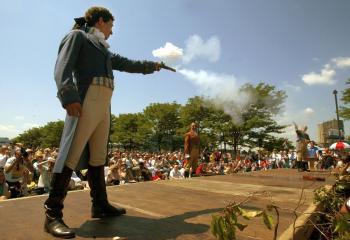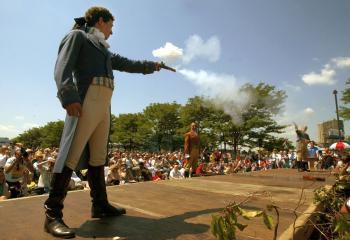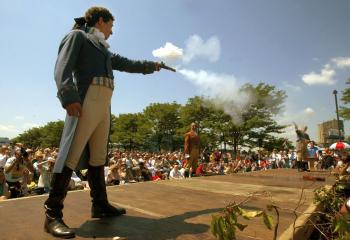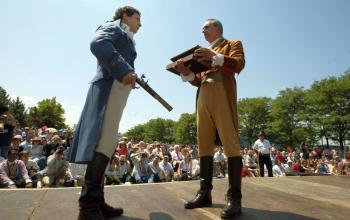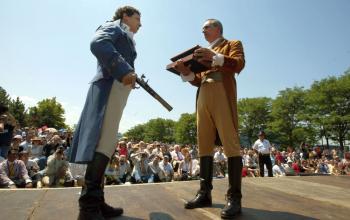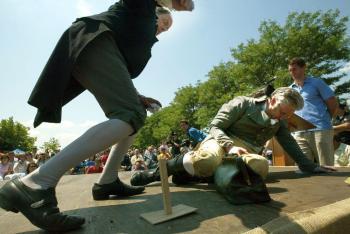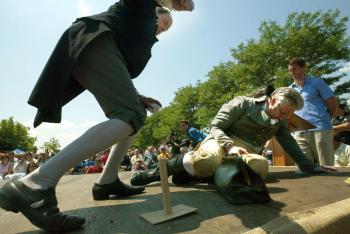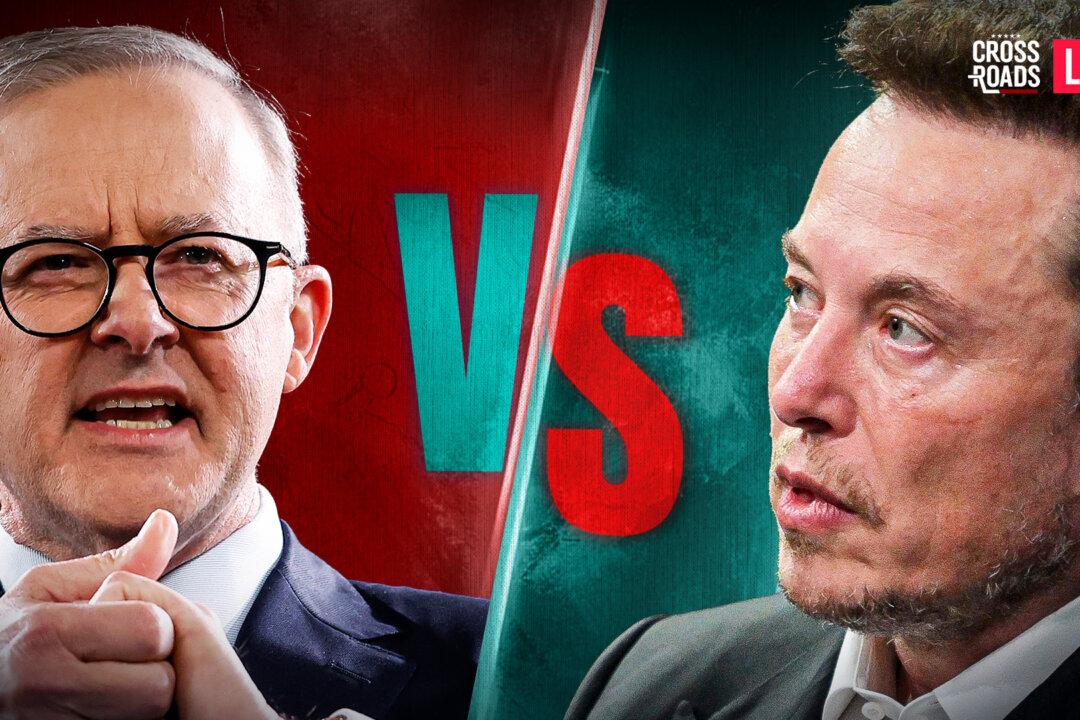NEW YORK—History remembers Aaron Burr as little more than the scoundrel who mercilessly took the life of Alexander Hamilton—the first Secretary of the Treasury whose face is immortalized on the $10 bill.
Both men were among the founding fathers of the United States—famous for their valor in the American Revolution, having a voice in the writing of the U.S. Constitution, and helping build the early foundations of today’s America.
It was on July 11, 1804 when the two took up arms against one-another. The former vice president Aaron Burr and the former secretary of treasury Alexander Hamilton met across the Hudson River in Weehawken, New Jersey in what would be the most famous duel in American history.
Debate is still ongoing over the true events that day—with the only accounts being records left from history—yet, what happened destroyed the lives of two of America’s most influential forefathers.
Hamilton is remembered as the hero of the tale, while the history of Burr is often told in a dark light; remembered as the man who killed the beloved Hamilton before being charged with treason against the United States for a later incident.
To learn the other side of the story, The Epoch Times spoke with Dr. Antonio Burr in his Manhattan office. Mr. Burr is a doctor of forensic psychology, a descendant of the Burr name, and a member of the Burr Association historical society.
“Burr was essentially a visionary rather than a traitor,” said Mr. Burr.
Both Aaron Burr and Hamilton were among the most influential names in American history and sit as founding fathers alongside George Washington, Thomas Jefferson, and Samuel Adams.
“So he came from a very illustrious past, and the family—the Burrs—were very patrician and privileged,” Mr. Burr said.
The lives of Hamilton and Burr were always close. Both became lawyers in and worked in downtown New York City, which Mr. Burr added “was a pretty small place at that time.”
When the American Revolution broke out, both Burr and Hamilton were on the front lines. Hamilton served under Washington and Burr served under General Richard Montgomery. Burr obtained the rank of Colonel, while Hamilton reached the rank of General.
“Hamilton made a career through his association with Washington and was a very, very smart guy,” said Mr. Burr, adding that “Burr lasted about a month in Washington’s headquarters. He was not the kind of guy to be in that kind of organization. He thought that everybody was a fool and he did not suffer fools gladly.”
Rising Tension
Following the American Revolution, both entered the political sphere. Burr went to the legislature of New York State, becoming attorney general for New York, and was later elected to the U.S. Senate.
“Interestingly, when he was elected senator the other person who was running for Senate was Hamilton’s father-in-law. Hamilton had managed to marry into a very prominent family from upstate New York,” Mr. Burr said.
Hamilton, who became the Secretary of the Treasury also went on to found the first Federal Reserve, the Bank of New York.
Although their careers aligned closely, Mr. Burr explained that the differences between the two had roots in their political stances. “They were political enemies,” he said. “Burr was a Republican and Hamilton was a Federalist.”
Since the Bank of New York was owned by the Federalists, receiving funds for his political ambitions was not an easy task for Burr. Thus, through loopholes in the system, Burr founded the Manhattan Bank—an action that was disguised as a business to bring water from upstate New York.
Through similar loopholes, Burr also found ways to allow average Americans to vote. Since only landowners were allowed to vote, he founded Tammany Hall, allowing multiple people to buy small parts of a plot of land—making them all landowners.
“Burr was, in a way, the first modern politician in the United States,” said Mr. Burr. “Hamilton thought the rabble in this country would destroy the country… Hamilton thought that only the aristocracy was fit to rule. Burr was not afraid of masses of people having access to the political process.”
Burr sought still higher ground and ran against Thomas Jefferson for the third presidency of the United States. In those days, the candidate who received the most votes would be president and the candidate who came in second would become the vice president.
Burr lost and became the vice president. Jefferson never fully forgave Burr, making his position as the vice president little more than a title. Realizing he had no future in the Jefferson administration, Burr set out to run for mayor of New York.
“That’s when the rivalry with Hamilton became more accentuated,” said Burr.
Hamilton is reported as calling Burr “a dangerous man, and one who ought not to be trusted with the reins of government.”
“Burr always felt that he never had to answer to these things,“ said Mr. Burr. ”He would hear the rumors of what Hamilton had said or what journalists had said in the newspapers.”
The way Mr. Burr tells American history, Burr quietly endured the criticism until Hamilton was quoted in the Albany Register saying something about Burr that Burr considered “more than despicable.” Though what that exactly was remains a mystery.
The Duel
In the days of Hamilton and Burr, the code of honor was held in esteem among gentlemen. “If you lost your honor, you were destroyed professionally, you were destroyed politically,” Mr. Burr said.
“Burr lost the election as well, so he probably had absolutely had it,” he said.
Burr demanded an apology from Hamilton and an exchange of letters followed. Unsatisfied with Hamilton’s response, Burr challenged Hamilton to the duel that would go down in history. Since dueling was forbidden in the State of New York, the two crossed the Hudson River to a spot in Weehawken, New Jersey.
Unknown to Burr, Hamilton, who was a talented writer, had written letters before the duel stating that he would waste his shot, that he had no animosity towards Burr, and that he did not believe in dueling. “Hamilton wrote the federalist papers. He left a tremendous amount of writing. He is sort of the winner in this story so we look at that part of history through the eyes of Hamilton,” said Mr. Burr.
In the moment before the duel began, Hamilton is reported to have put his glasses on and checked the aim on his gun—not exactly the actions of somebody who plans to waste a shot.
When the duel began, Burr aimed and fired, hitting Hamilton in the side where the bullet bounced off a rib and lodged itself in his lower spine. He stood on his toes, twisted, and fell.
There are mixed records as to who fired first. Hamilton’s bullet was found to have shot close to 12 feet over Burr’s head—nowhere near its mark. It is still unsure if the shot was fired during the duel or if it was fired after he was shot.
Hamilton was taken to a house in New York where he passed away with his family near his bedside. He lasted for up to 48 hours.
“Then these letters come out written by Hamilton saying, I have no intention of shooting. I have no animosity. I am the victim in this thing,” said Mr. Burr. “It turned the whole story around. It turned Burr into a really bad guy who had practically committed homicide, not a guy who was there to defend his honor.”
Into Exile
The duel ended Burr’s political career. With Americans enraged by the death of Hamilton, Burr was driven from New York City.
After the incident, Burr decided to raise an army to try and take the Western states from Spain. Jefferson saw this as an act of treason, fearing Burr was aiming to overthrow the U.S. government.
In the famous trial of 1807, known as “The United States against Aaron Burr,” the once proud vice president and colonel, Aaron Burr was taken to Richmond Virginia where he was charged with treason.
Although Burr was pronounced “guilty beyond doubt” by Jefferson, he was acquitted and set free.
Mr. Burr said that despite Burr’s release, “he realizes he has no political future left. He is hated because he killed Hamilton and he is, in the media, condemned as a traitor.”
Following the trial, Burr went into self-imposed exile for several years in Europe.
Although in his early years he never showed signs of remorse for killing Hamilton, in his later years Burr once said, “If I had read Sterne more, and Voltaire less, I should have known that the world was wide enough for Hamilton and me.”
